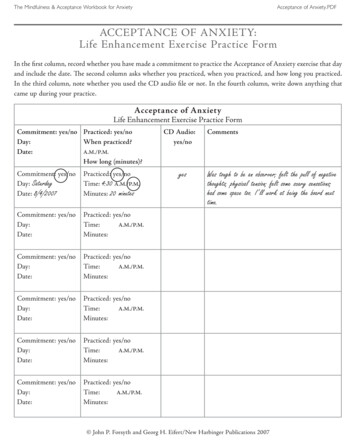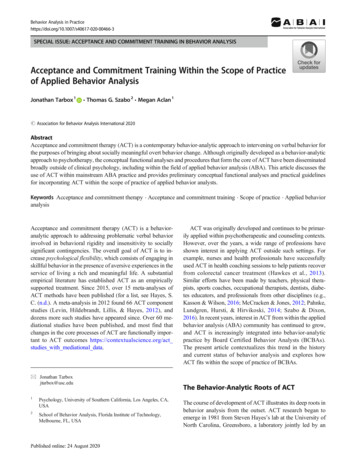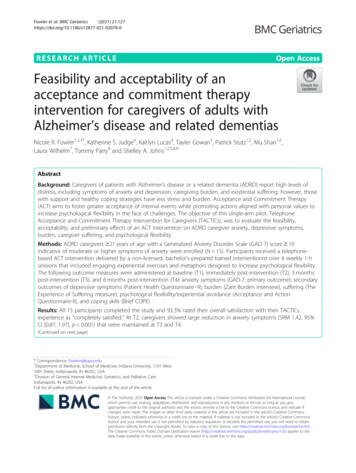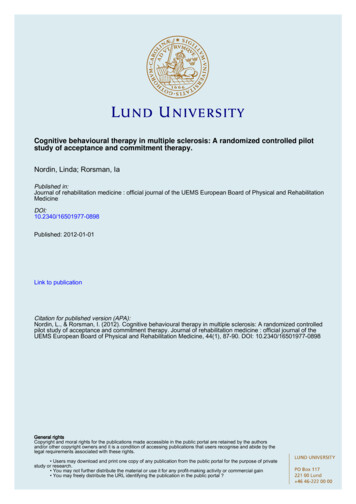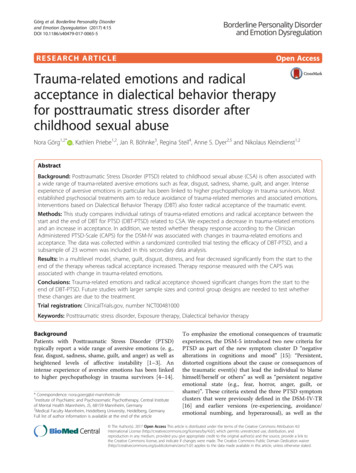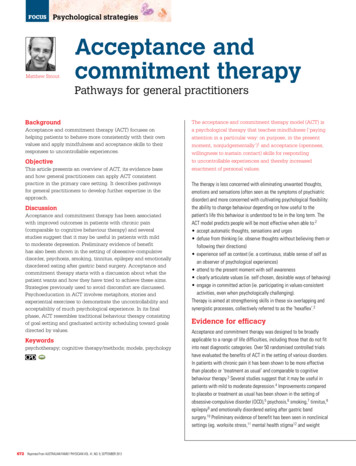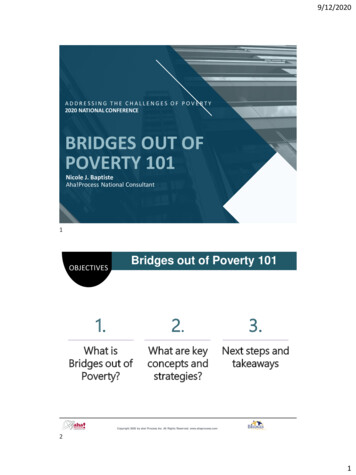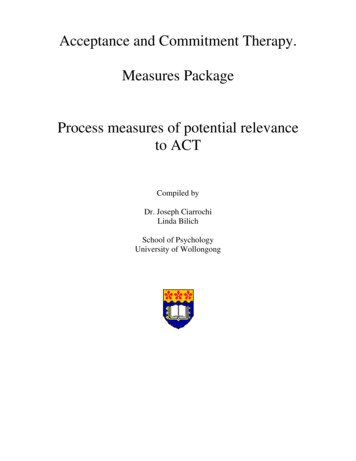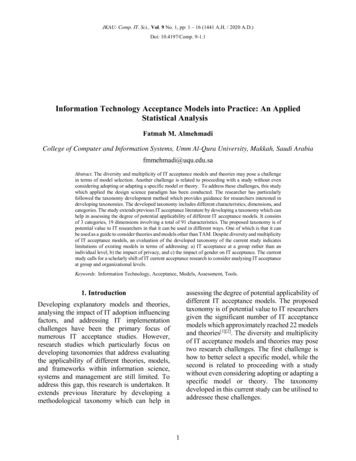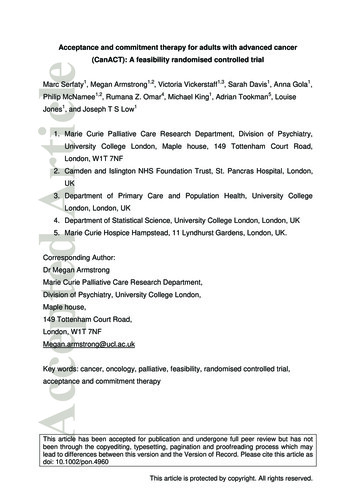
Transcription
Presented by:Rhonda M. Merwin, PhDAssistant Professor of Psychiatry andBehavioral SciencesDirector, ACT at DukeDuke University Medical CenterPeer-Reviewed ACT Trainer, ACBSUNC School of Social Work, April 7-8, 2016(**some slides courtesy of the generous ACTcommunity)Advancing Skills inAcceptance andCommitmentTherapy (ACT):A 2-DayIntermediateWorkshop
Other Resources www.contextualscience.org http://www.actmindfully.com.au YouTube – Steve Hayes, Kelly Wilson, KevinPolk, Russ Harris ACT 2nd ed. (Hayes, Strosahl, Wilson) ACT Made Simple (Harris) Learning ACT (Luoma) or Get Out of YourMind and Into Your Life (Hayes) Mindfulness for Two (Wilson) A Practical Guide to ACT (Hayes, edited)
Set an Intention Whatare you going to be about over thenext 2 days? How much of yourself willyou bring? How much willingness and forwhat?
ContextualScienceBehavioral
AnxietyLeaveReliefNegative Reinforcement
Impactof aversives on behavioralvariability (it narrows us, flexibility is thegoal)
Language(or symbolicbehavior) and a culture ofcontrol.
Respondingnot just to the world, but alsoour verbal formulations of the world.
“Pushthe button slowly to win points ”
As we become more verbal, we begin to livemore in the verbal construction of the worldand less in the actual worldWe listen to our minds, rather than to ourexperienceThe solution is to
Notonly do we start living in a dream, butlanguage also creates unique suffering inhuman beings. It’s like this: We are reinforced for treatingwords like the events that they represent
“Apple”
“Where’s theApple?”
Words“stand in” Some of the psychological functions ofevents are present in the words aboutthem (ex. Car) Highly adaptive on the savannah
You are not enough.
means we can “experience” thingsAnytime. Anywhere. Right nowTrauma Wecan’t control pain by controlling theenvironment, so we try to control ourthoughts and feelings.
Amplified by our culture thatteaches us Thenatural state of the human is not onlythe absence of pain (including painfulthoughts and feelings), but also thepresence of positive feelings. Humans are meant to be happy and weshould strive for happiness.
Controlworks well sometimes. It also fails miserably.
Workingto control our feelings, we losecontrol over our lives. We invest needless energy that would bebetter spent elsewhere. We avoid things we care about becauseof the potential for painful feelings.
Inwhat area of life are you on anemotional avoidance detour?
Thoughts and feelingsthemselves are notpathogenic.Our culture of control is thecancer.What if bad feelings arenot themselves problems tobe solved? What if we arenot problems to be solved?
StrugglePainLife will turn on the pain switch.
StrugglingWithSadness(e.g., withdrawal toavoid a world thatfeels painful)Sadness Considerdiagnosticsyndromes It is emotion strugglewith emotion MDD,Anxiety disorders, etc.
The way out is in. Into willingnessFinger traps and quicksand
ACTchanges how werelate to thoughts andfeelings, rather thanchanging the thoughtsand feelings themselves
“I amUnloveable.”Avoid IntimacyFusion/literality
Whatit sounds like Sample
Sad/LonelyCut. Binge.Use Substances.Emotional Control
Whatit sounds like Sample
35FearKnot instomach“I have no ideawhat I am doing.”Urge towithdrawWork harderGive up
Sothat behavior can be flexible andeffective -- The goal is flexibility in thepresence of difficult or compellingthoughts and feelings Stay present, sensitive and connected tovalues Not just or must
definitions ACTtargets cognitive fusion (i.e.,overattachment to the content of mental activity)and experiential avoidance (i.e., attempts toavoid, suppress, attenuate unwanted internalexperiences when doing so causes psychologicalharm) thatinterferes with individuals behaving inways that are effective for the situationand consistent with deeply held, personalvalues.
Or psychological inflexibility.
Psychological flexibility Theability to contact the present moment, fullyand without defense, and cease or persist inbehavior based on our values and what wouldbe most effective in the situation
Engaging 6 Core Processes With defusion (decreasing attachment to thecontent of mental activity)With acceptance (increasing willingness toexperience unwanted thoughts/feelings)With contact with the present moment (practicingflexible attention to events as they occur)With self-as context (strengthening the observer selfperspective)With values (articulating what is most meaningful)With committed action (aligning activity with thosevalues)
Case formulation/Treatmentplanning Startwith functional assessment (timelines,diary cards, chain analyses, CRBs etc.) Use diagnosis as starting point foravoidant repertoire
This is also intervention. Avoidance/controlhas deep roots. Tilling the soil to prepare for somethingnew. Guided exploration of the workability ofactions: “and how has that gone ” “So, let me see if I am hearing this right,the situation is something like this ”
Contact with the Present MomentDominance of the conceptualizedfeared future & regretted pastValuesLack of values clarity;Dominance of pliance andavoidant tracking; valuesavoidance; values as inflexibilityDefusionInaction, impulsivity, oravoidant t to conceptualizedself; Impoverished sense of selfSelf as Context
Contact with thePresent MomentFusionSelf-ascontext
Contact with thePresent ext
Contact with thePresent tionSelf-ascontext
Movefrom listening to thoughts tolistening to experience (WORKABILITY) Move from fighting with feelings toembracing feelings (WILLINGNESS)
eValuesDoWhatMa:ers
Nonacceptance Ignoring,suppressingor denying feelings Resignation, giving inor giving up, secretlyhoping for change Organizing life toavoid feelingsAcceptance Openness to feelingsas they ariseAn active choice toembrace feelingsApproachingsituations that maybe uncomfortable
Fusion Being entangled (or lostin) in one’s thoughtsFighting with one’sthoughtsTrying to decide if (orconvince that) thoughtsare true or not trueListening or buying intothoughts despiteunworkabilityDefusion Watching thoughtsHolding thoughts lightly asone feature of an internallandscapeAppreciating otheraspects of experience,not just what the mindsaysBehaving in ways that arecontrary to thoughtssometimes
Reallyexists on a continuum. Can track between and across sessions.
Valuesare distinguished from goals Values are offered as an alternative to“listening to thoughts” or “running fromfeelings” Provide direction when we feel “lost” like a compass or lighthouse, leading the way
Valuesalso dignify the pain inherent inliving (recontextualize pain) What if there is something important inthat?Mule in the well
Identifying ValuedDirections (a “What for”) Manypeople will be clear about whatthey have lost in the struggle
Andif you know what is painful, youprobably know what they care about What is your worst fear? What is mostimportant to you? Are they related? Sweetspot What if X was gone?
Negative thoughts, emotions, bodily states,memories, competing behavioralpredispositions,lack of motivation, confusion, ULNESS
Acceptance &MindfulnessProcessesContact with thePresent MomentCommitment& BehaviorChange lf asContext
Detecting “Mind” Old, familiar, lifelessFull of comparison and evaluationBusy, complexButs and shouldsStrong past or future orientationLots of warningsDisruptions in behavioral variability andsensitivity to the environment
Detecting Openness New, fresh, clearMe, here and nowA sense of choice, decisivenessFocus on being effectiveFeels vital, meaningfulMight be expansiveBehavior is appropriately variable and sensitive tofeedback
ParallelProcessIt applies to us too.
ACTis a model of humanfunctioning andadaptability, not a modelof psychopathology. It applies to us too.(mountain climbing)
EvidenceBased Practice
v APA Division 12 / Society of Clinical tments/) listsACT as a research supported treatment for:v v v v Chronic PainDepressionMixed AnxietyPsychosisv SAMHSA’S National Registry of Evidenced BasedPrograms and Practices n.aspx?id 191 lists ACT as an evidence based practicetreatment for:v v v v OCDDepression SymptomsRehospitalizationGeneral Mental Health
August&2014:&104&ACT&RCTs&N 8"24"13"19"20"0" 1"1985"2"1990"1995"3" 4" 5" 9"2000"2005"2010"2014"
ACT RCTs as of August 2014PainDepressionStressAnxietyVariousWeight LossSubstance AbuseSmokingCancerEating DisordersSocial AnxietyPsychosisEpilepsyBorderline Personality maniaOCDPrevention161311876554443222222111
Extra 6 Process Slides (somecontent overlaps)
AcceptanceActive embrace of internalexperience (difficult thoughts,feelings, body sensations,urges, memories)
Acceptance/Willingness Openingup to uncomfortablethoughts, feelings, body sensations,urges, memories etc. Letting go of the struggle so that wecan live more freely and consistentlywith our values You don’t have to like it, want it,approve of it, in order to accept it
73Acceptance is not resignationIt is not “giving in” or “giving up”It is also not “gritting your teeth & bearingit”It is ACTIVE not PASSIVEIt is a CHOICE to stop fighting feelingsv v v v v v v to be willing to let them come or go as they willto be willing to go into hard spaces b/c theremight be something important about that
Deeproots
Building acceptance orwillingness Ifyou aren’t willing to have it, you got it White bear, polygraph You can keep it away for a while, but it takeseffort Closet full of stuff, pushing against something,tug-of-war with a monster, throwing balls/cards,uninvited guest Costs accumulate (pain of absence) Card file exercise
A counter-intuitive solution The way out is inChinese finger trap, quicksandNotice the freedom in that Wedon’t have control over the painswitch, only the struggle switch
Goal:Create a context of emotionalwillingness/disrupt the context ofemotional control, build out a broad andflexible repertoire of relating Anything other than avoidance is good J
Recontextualizing Mulewith valuesin the well I could take away pain, but then youlose X Metaphor that pulls for kindness/compassion/gentleness Baby, gift, precious gem Competing repertoire Scientist, witness Object (curiosity, you have objects,they don’t have you)
Unexpectedreactions Using an object to observe how the clientis relating to a thought/feeling, andpractice relating differently (e.g., cards)
Experientialexercise
DefusionDecreasingoverattachment to thecontent of mental activity
Recognizewhen listening to our mind isand is not helpful Workability is the metric What happens if you take the advice thatthought would give?Does it get you where you want to go?(sidestep truth, logic etc., it’s irrelevant)
Metaphors that highlight the nature of “mind”and its limits Sensitive car alarm, bad news radio, worldsgreatest story teller, a masterful salesmanInstruct nonverbal or sensory based experienceActive language that separate the client andmind (and highlight client as response-able) Thank your mind, who’s talking here .Pushed around, buying, hooked, listening
Metaphorsthat pull for an observerstance (observing the dynamic process ofthinking) Parade, passing cars, leaves on a stream,ticker tape, baggage claim Experientialobservation
Changing the auditory cueSing it, say it fast or slow, etc. Metaphors that label fusionStory, chapter, book, familiar script
PresentMomentThe future and past are trueillusions. The only thing thatexists is this moment.
Virabhadrasana II(Warrior II)Here there is nothing to fightExcept willfulness.Some lean too farInto the past.Others stretch way outInto the future.The true warriorStays in the moment,Burning deeperInto whatever comes,Or sometimes withEven more difficulty,What doesn’t.
Strongpast or future orientation Fixed or inattention Experiential exerciseYou have arrived.
Self-asContextThe observer self
Self-as-Context/Observer Self(Distinguished from Self-as-Contentor the Conceptualized self) Ourlanguage encourages fusionbetween ourselves and our thoughts,feelings, roles, content, etc. I amHard to deviate from self-story, threatenedby the presence or absence of content Needvariation but not overattachment –might build out content, but all held lightly
Metaphors of “bigger than” Experiencing that you are the observer of soyou mustn’t be those experiences Observer self exerciseNoticingStage showMeditations Sea floor, chessboard, sky with clouds, housewith furnitureKabat Zinn – Mountain MeditationAll defusion has SAC
Values
If you are not going to be guidedby momentary thoughts andfeelings, what are you going tobe about?What will guide you?
Metaphorsthat highlight values asshowing the way when we are lost (inthoughts or feeling) Compass, lighthouse
What do you want your life to stand for?Tombstone, epitaph, eulogy, 80th bdayWhat if no one knew?
Enter through vulnerability Whatis your worst fear? Theremust be a pony.
Enter through memoryRecall a sweet moment, a moment where youfelt most connected, where there was a sense ofvitality (not necessarily joy or happiness butvitality)
Imagine if/Magic wandIf I could take away, the what?Imagine is no longer and issue, whatwould you want to be doing? What wouldyou want to be about?
Structure a conversation Values Inventories HealthPersonal GrowthLeisureI want to be a person who Rate importance, consistency
Tools to look at consistency in behaviorRecording cardsBulls eye exerciseCups and beans/time allocation
Process, not outcome It’sthe process of behaving consistentlywith values, not the outcome Example of holding the door openSkiing metaphor Youmight do with reasons, but not forreasons.
Not about believing or feeling,but behaving Youcan think and feel other ways and stillchose value consistent action Chosen qualities of purposeful action Love vs. behaving lovinglyArgyle socks
Coming back Notabout being perfect – it’s abouttaking a stand Noticing when we are sideways, comingback, and recommitting In what area of your life are mostconsistent? Least? What is showing up thatis pulling you off course?
Values and WILLINGNESS What do you want to be about? Reasons, beliefs,avoiding pain THE CHOICE
RejectionIntimacyYou can toss one,but not without getting rid of the other.
Acceptance and Commitment Therapy (ACT): A 2-Day Intermediate Workshop Presented by: Rhonda M. Merwin, PhD Assistant Professor of Psychiatry and Behavioral Sciences Director, ACT at Duke Duke University Medical Center Peer-Reviewed ACT Trainer, ACBS UNC School of Social Work, April 7-8, 2016 (**some slides courtesy of the generous ACT community)
